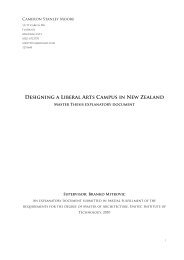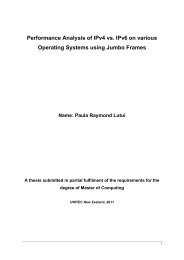The Study of Students Perceptions of On-campus ... - Research Bank
The Study of Students Perceptions of On-campus ... - Research Bank
The Study of Students Perceptions of On-campus ... - Research Bank
You also want an ePaper? Increase the reach of your titles
YUMPU automatically turns print PDFs into web optimized ePapers that Google loves.
truly mobile computing solution” (Nisbet, 2004). By studying those two<br />
cases, Nisbet concluded “the decision to install a wireless network in a<br />
<strong>campus</strong> environment is a major strategic initiative for an organisation”<br />
(Nisbet, 2004).<br />
Nisbet (2004) had mainly studied two cases. <strong>The</strong> two cases were both in<br />
private schools and the students were teenagers. All form 7 students from<br />
the first school and all students from the second school were required to<br />
purchase Toshiba laptops and carry them to school. From the educators’<br />
perspective, the same brand <strong>of</strong> laptops was easier to support and manage,<br />
but from the students’ perspective, they were restricted and lost their<br />
choice. Although the second school allows students to chose another brand,<br />
the students will lose the hardware and s<strong>of</strong>tware support from the school.<br />
Brawn, Koan & Caye (2004) outlined the authentication process <strong>of</strong> wireless<br />
network services on <strong>campus</strong> at Arizona State University West (ASU West).<br />
<strong>The</strong> authentication process incorporated security for both wired and<br />
wireless networks. <strong>The</strong> 802.1x security protocol was used for this<br />
authentication process. Compared to the Micros<strong>of</strong>t PPTP VPN, which was<br />
the previous encryption protocol, the 802.1x was faster and scalable. <strong>The</strong>re<br />
were more advantages in using the 802.1x to replace the Micros<strong>of</strong>t PPTP<br />
VPN. For example, the 802.1x required at least a minimum encryption<br />
which made the traffic in the wireless network safer. <strong>The</strong> authors defined<br />
the IEEE 802.1x authentication as a standard Extensible Authentication<br />
Protocol (EAP) for 802.11 wireless local area networks. <strong>The</strong> article stated<br />
that the client, access point and the authentication server were the main<br />
components <strong>of</strong> the 802.1x authentication. <strong>The</strong>n each <strong>of</strong> the main<br />
components were explained and presented in the article. <strong>The</strong> 802.1x<br />
authentication consisted <strong>of</strong> five steps and it started from sending packets<br />
from the client side to an access point, then passed on to the authentication<br />
12











